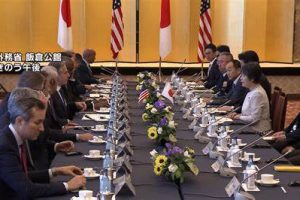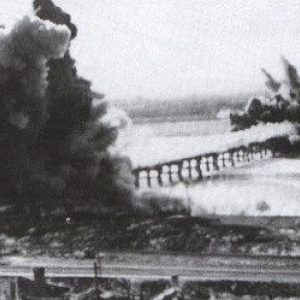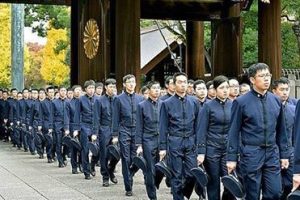In the draft amendment to the Constitution published in April 2012, the Liberal Democratic Party advocated the creation of a national defense force, and listed its role as "activities to protect the lives or freedom of the people." In response, four months later, the United States issued the Third Armitage Report, a directive to Japan in 2012, which warned that "the current peace constitution should not be changed" and ordered the status quo of the Self-Defense Forces to be maintained. The Self-Defense Forces, which succeeded the National Police Reserve, which was hastily established two months after the outbreak of the Korean War in June 1950, and the National Safety Forces, which were reorganized from it, were originally intended to complement the US military in Japan, which had been deployed to the Korean Peninsula and left a vacant position. The Self-Defense Forces Law only lists " the peace and independence of our country, the maintenance of national security, and the defense of our country" as its main mission, and does not specify the protection of the basic rights of the people, such as "the lives, (property), and freedom of the people," which was even mentioned in the LDP draft. This is because the origins of the Self-Defense Forces lie in the defense of the Japanese mainland, with the highest priority placed on the defense of U.S. military bases and facilities, responding to an invasion by communist forces from the Korean Peninsula and elsewhere, and maintaining public order in Japan in preparation for large-scale terrorism and riots. The Japan-U.S. 2+2 meeting held in Tokyo at the end of June was a farce in which Japan and the U.S. tried to play the role of equals. This is because the substance of the agreement was to make public for the first time the fact that the Self-Defense Forces are under the command of the U.S. military, something that has remained ambiguous since the establishment of the Self-Defense Forces in 1954.
■ Triple containment
 Why did the US government ask for the Japan-US Security Consultative Committee (2+2) to be held in Tokyo on July 28th, consisting of the Ministers of State (foreign affairs) and Defense (defense)? It is likely because August is the month when Japan once again recalls its pledge to "build a peaceful nation," which it has been vocal about for a certain period since the defeat of the war, including the anniversary of the atomic bombings of Hiroshima and Nagasaki, and the de facto anniversary of Japan's defeat in the war. It is thought that the US government wanted to inform the Japanese people that Japan, which has been in the process of for almost 80 years since the end of the war, is facing a major turning point just before that. Since 2010, the Japanese and US governments have been discussing at the working level "extended deterrence," which would defend Japan with the nuclear forces of the US. By intentionally raising the talks to the ministerial level this time, the heartbreaking appeal of the atomic bomb survivors for a "world without nuclear weapons" has been completely dismissed as unrealistic, using the pretext of China and Russia's nuclear buildup and North Korea 's nuclear and missile development.
Why did the US government ask for the Japan-US Security Consultative Committee (2+2) to be held in Tokyo on July 28th, consisting of the Ministers of State (foreign affairs) and Defense (defense)? It is likely because August is the month when Japan once again recalls its pledge to "build a peaceful nation," which it has been vocal about for a certain period since the defeat of the war, including the anniversary of the atomic bombings of Hiroshima and Nagasaki, and the de facto anniversary of Japan's defeat in the war. It is thought that the US government wanted to inform the Japanese people that Japan, which has been in the process of for almost 80 years since the end of the war, is facing a major turning point just before that. Since 2010, the Japanese and US governments have been discussing at the working level "extended deterrence," which would defend Japan with the nuclear forces of the US. By intentionally raising the talks to the ministerial level this time, the heartbreaking appeal of the atomic bomb survivors for a "world without nuclear weapons" has been completely dismissed as unrealistic, using the pretext of China and Russia's nuclear buildup and North Korea 's nuclear and missile development.
The US-Japan 2+2 meeting this time allowed a glimpse of the real faces beneath the makeup. The biggest focus was on the command and control relationship between the two militaries. It was stated that " the Joint Command Headquarters of the US Forces in Japan will be located at Yokota Air Base, and the Self-Defense Forces will also establish a joint operational command for the first time to operate the three forces of the Army, Navy and Air Force. The joint command headquarters of both the US and Japan will work to strengthen cooperation," but it was not specified that the command structure of the Self-Defense Forces will be independent . This is natural, and it is obvious that the US military, which is overwhelmingly superior in terms of both equipment and intelligence, will bring the Self-Defense Forces under its command. In fact, the Air Defense Command Headquarters, the command and control organization of the Air Self-Defense Force, and the Air Rescue Intelligence Center (RIC) of the Maritime Self-Defense Force were relocated from Fuchu, Tokyo to Yokota Air Base in 2012 and are now under the command and control of the US military. The Joint Operational Command established by the Self-Defense Forces will be subordinated to the Joint Command of the US Forces in Japan .It's as clear as day.
Incidentally, the Fourth Armitage-Nye Report, a directive to Japan published by the Center for Strategic and International Studies (CSIS) in October 2018, ordered the Japanese government to "establish a combined joint task force " as one of its most important tasks. In 2014, the exercise of the right of collective self-defense was approved, and the Self-Defense Forces were said to be able to operate globally as a complementary force to the U.S. military. In that case, the Self-Defense Forces in the Japan-U.S. combined task force will definitely be under the command and control of the U.S. military. In other words, they can be said to be Japanese troops incorporated into the U.S. military. The recent Japan-U.S. 2+2 joint document was vague, saying " We will strengthen cooperation regarding the command and control structure between Japan and the U.S." For the sake of appearances, they cannot say "the Self-Defense Forces will be under the command of the U.S. military," much less tell the obvious lie that "the U.S. military may be under the command and control of Japan."
■Replacement for the vacant U.S. military bases in Japan
First of all, how did the United States intend to use the Self-Defense Forces, including the National Police Reserve , which it established during the occupation period ? In June 1950, North Korean forces crossed the 38th Parallel and invaded South Korea, starting the Korean War. It is said that then- U.S. Secretary of State Dean Acheson said in a January 1950 speech that in the Far East,It is said that the failure to clearly express its intention regarding the Korean Peninsula, citing Japan, Okinawa , the Philippines , and the Aleutian Islands as the "Acheson Line," an "unretractable defense line" to contain Communism and resolutely fight back against military aggression , was a major factor in provoking the Korean War . However, what must be emphasized even more is that not only the Truman administration, but also General MacArthur , the Supreme Commander of the Far Eastern Army, did not have much interest in the situation in Korea. The decisive triggering factor seems to be when Kim Il-sung, sensing a military relaxation between the United States and South Korea that " there will be no military action on the Korean Peninsula ," obtained Stalin's consent to the invasion.
Since assuming his post in August 1945, MacArthur has devoted himself to governing Japan and has only visited the Korean Peninsula once. MacArthur, who disliked the CIA, did not take seriously information on the movements of the North Korean military, even though he received repeated information that North Korea was preparing to advance south . It was only a few days after the invasion on June 25th that he finally began to understand the seriousness of the situation when he received information from the State Department that "South Korean forces are in rout." John Allison, the US Ambassador to Japan who accompanied Secretary of State Adviser John Dulles during his visit to Japan, recalled, "I never would have imagined that a representative from the State Department (Dulles) would end up informing the Supreme Commander of the US military (MacArthur) about what was happening in his own backyard..."

[ Photo] South Korean troops blew up a bridge over the Han River and escaped, sacrificing Seoul citizens.
Shaken, MacArthur immediately headed to Korea, where he witnessed Seoul in flames and the devastated state of the South Korean military. He then received permission from President Truman to send all of the U.S. Army forces stationed in Japan (the Eighth Army) to Korea. But how would they defend the vacant U.S. military bases in Japan, maintain public order in Japan, and prepare for terrorism and unrest caused by an invasion by communist forces from the Korean Peninsula, the Kuril Islands, Sakhalin, and elsewhere? The White House's National Security Council (NSC) had been discussing "limited rearmament of Japan" since 1948 , but was alarmed by the rapid developments.
Nevertheless, the paramilitary National Police Reserve was established less than two months after the outbreak of the Korean War on June 25, 1950. This was just one month after the entire 8th Army had been transferred to the Korean Peninsula. To the Japanese, it was insisted that this was not rearmament but an increase in police power, but from the start it was a heavily armed unit equipped with light tanks and howitzers. By early October, the number of enlisted personnel had exceeded 74,000. Two years later it became the National Safety Forces, and two years after that it became the Self-Defense Forces. Rearmament was achieved by the anxious United States, who took advantage of the confusion to get the cooperation of former Japanese military personnel. From the start, the United States was forced to make various secret agreements, including one that "in the event of an emergency, the Self-Defense Forces would be under the command of the U.S. military."
■ Permanent postwar = symbol of permanent defeat
Given this history, it is unreasonable to think that the SDF is an organization that is independent from the US military, even if only to a certain extent, and whose main purpose is defense to protect the lives and property of the Japanese people. With the exception of disaster relief activities, the SDF has always been a complementary military force to make up for the shortcomings of the US military in terms of military affairs. However, since then, in 1955, the year after the SDF was established, then Defense Agency Director General Sugihara mentioned " exclusively defensive defense" in a response to a question in the Diet , the Japanese people have been led to believe that the SDF is a powerful organization that defends Japan within the framework of the Peace Constitution . With Japan's subsequent dramatic economic growth, demands from the US side escalated. Voices calling for a fair share of the burden and sharing of responsibilities grew louder, and after criticism of free riding on the security treaty, the consideration budget for the US military stationed in Japan continued to increase without limit. And before we knew it, the term "Japan-US alliance" became established, which makes people mistakenly think that the two countries are equal allies.
During his visit to the United States in April 2024, Prime Minister Kishida stated in a speech to the U.S. Congress that "Japan and the United States have become global partners based on stronger friendship and trust than ever before." Global partnership means military cooperation between Japan and the United States on a global scale. In other words, it is a pledge to make the Self-Defense Forces a global complement to the U.S. military. In the 1990 Gulf War, Washington shocked the Japanese government by demanding that the Self-Defense Forces be deployed "not only for money but also for blood." After that, the Self-Defense Forces' overseas deployment escalated in the name of international contribution , starting with international peacekeeping operations (PKO) and the dispatch of minesweepers . In 2014, under the second Abe administration , a cabinet decision was made to approve the exercise of collective self-defense rights, which goes beyond the legal principle that the joint use of force by the Self-Defense Forces with the U.S. military overseas does not violate Article 9 of the Constitution. The Kishida administration insists that the demand for the abolition of nuclear weapons is not contradictory to the refusal to sign the Treaty on the Prohibition of Nuclear Weapons. This, including the current state of the Self-Defense Forces, is a symbol of subjugation to the United States, in other words, permanent post-war = permanent defeat.
 When one examines the history of the National Police Reserve, National Safety Forces, Self-Defense Forces, and the National Defense Academy, the issue that the US should be most wary of is the deep remnants of the former Japanese military that have accumulated in the Self-Defense Forces-related organizations. As mentioned above, because they were organized in such a hasty manner, there are many problems that go against the occupation policy, such as the early return of former military personnel who had been purged from public office, the hiring of former military officials of the rank of colonel or higher, the formation of former military circles in the Self-Defense Forces and the Defense Agency, the issue of former Chief of Staff of the Air Self-Defense Force Tamogami as a symbol of this, and the issue of National Defense Academy students walking all night from Yokosuka to Yasukuni Shrine . If the Kishida administration survives beyond September, the next issue will be to quickly clear away the remnants of the prewar era, following the Abe issue.
When one examines the history of the National Police Reserve, National Safety Forces, Self-Defense Forces, and the National Defense Academy, the issue that the US should be most wary of is the deep remnants of the former Japanese military that have accumulated in the Self-Defense Forces-related organizations. As mentioned above, because they were organized in such a hasty manner, there are many problems that go against the occupation policy, such as the early return of former military personnel who had been purged from public office, the hiring of former military officials of the rank of colonel or higher, the formation of former military circles in the Self-Defense Forces and the Defense Agency, the issue of former Chief of Staff of the Air Self-Defense Force Tamogami as a symbol of this, and the issue of National Defense Academy students walking all night from Yokosuka to Yasukuni Shrine . If the Kishida administration survives beyond September, the next issue will be to quickly clear away the remnants of the prewar era, following the Abe issue.
